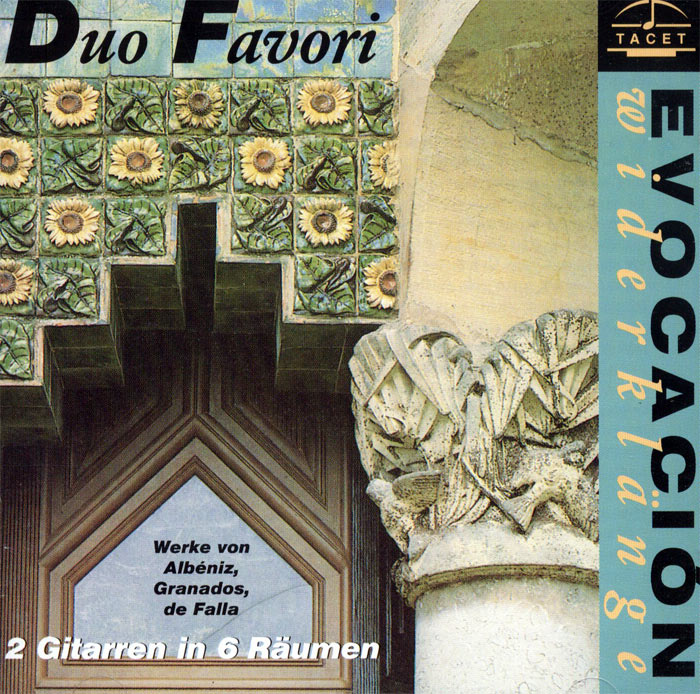Logowanie
KOLEKCJE!
BACH, CHOPIN, LISZT, MOZART, GRIEG, Dinu Lipatti, Otto Ackermann, Ernest Ansermet
The Master Pianist
PROKOFIEV, CHOPIN, TCHAIKOVSKY, SCHUMANN, BEETHOVEN, Martha Argerich, Claudio Abbado, Giuseppe Sinopoli
The Concerto Recordings
The Collection 2
Jakość LABORATORYJNA!
ORFF, Gundula Janowitz, Gerhard Stolze, Dietrich-Fischer Dieskau, Deutsche Oper Berlin, Eugen Jochum
Carmina Burana
ESOTERIC - NUMER JEDEN W ŚWIECIE AUDIOFILII I MELOMANÓW - SACD HYBR
Winylowy niezbędnik
ClearAudio
Essence MC
kumulacja zoptymalizowana: najlepsze z najważniejszych i najważniejsze z najlepszych cech przetworników Clearaudio
Direct-To-Disc
PIAZZOLLA, ChamberJam Europe
Tangos del Ángel y del Diablo
Direct-to-Disc ( D2D ) - Numbered Limited Edition
ALBENIZ, GRANADOS, DE FALLA, Duo Favori
Evocacion
- Evocacion
- 01. Enrique Granados - Rondalla aragonesa (4:31)
- 02. Enrique Granados - Zambra (6:39)
- 03. Isaac Albeniz - Rumures de la caleta (4:17)
- 04. Enrique Granados - Andaluza (4:35)
- 05. Isaac Albeniz - Castilla: Seguidillas (3:24)
- 06. Enrique Granados - Danza triste (4:45)
- 07. Manuel de Falla - Danza del molinero: Farruca (3:01)
- 08. Enrique Granados - Villanesca (6:05)
- 09. Manuel de Falla - Danza del corregidor (1:53)
- 10. Enrique Granados - Minueto (3:14)
- 11. Isaac Albeniz - Bajo la palmera (5:30)
- Duo Favori
- ALBENIZ
- GRANADOS
- DE FALLA
dwie gitary w sześciu akustycznie odmiennych przestrzeniach!
1 Enrique Granados: Rondalla aragonesa (4'30) 2 Enrique Granados: Zambra (6'39) - Comments: The microphones were suspended on a long cord vertically one above the other, swinging slowly between left and right in front of the musicians. This knocked the bottom out of the sound, which is particularly noticeable on long drawn-out notes (Doppler effect). 3 Isaac Albéniz: Rumores de la caleta: Malaguena (4'17) - The microphones were placed vertically one above the other. The result is a stereo sound, but the listener cannot place the guitars separately. 4 Enrique Granados: Andaluza (4'35) - Conventional positioning of the two microphones. The accompanying guitar was audibly closer to the microphones than the leading instrument. The sound of the solo melody was able to develop better in its surroundings, and the accompaniment sounds more restless. 5 Isaac Albéniz: Castilla: Seguidillas (3'24) - The microphones were placed very close together and at quite a distance from the musicians. "Acoustic mono" or "tunnel effect". 6 Enrique Granados: Danza triste (4'45) - The impression of closeness was created purely by means of the dull acoustics. The microphones were no closer to the instruments than for the other pieces. 7 Manuel de Falla: Danza del molinero: Farruca (3'01) - The microphones were placed above the instruments, pointing downwards. 8 Enrique Granados: Villanesca (6'05) 9 Manuel de Falla: Danza del corregidor (3'14) - The musicians were seated far apart, the microphones were positioned far apart. Strong stereo effect. 10 Enrique Granados: Minueto (3'14) 11 Isaac Albéniz: Bajo la palmera (5'28) - The microphones were secured to a bar at a fixed distance from each other, suspended from a cord which swung slowly back and forth. Floating sound effect as for track. The instruments can be perceived on the right and left. tip: "20-Bit-Prozessing, 4-D, Goldauflage, oder "hörphysiologisch angewandte Korrekturen der Laufzeit, die das Schallereignis braucht, um das Hauptmikrofon zu erreichen": Die Plattenindustrie läßt sich schon was einfallen, um uns zum Wegwerfen der eben noch als unübertrefflich geltenden Aufnahmen zu animieren. Die realen Fortschritte werden aber, gemessen am Aufwand, immer geringer... - Das kleine Stuttgarter Label TACET geht einen anderen Weg als die Konkurrenz. Bestes Beispiel ist "Evocacion", die neue Platte des Duos Favori mit Gitarrenmusik, die richtungsweisend für Kammermusik werden kann. Schon lange sind Aufnahmetechniker auf der Suche nach geeigneten Klangräumen jenseits der großen Konzertsaalatmosphäre. Um den unterschiedlichen Charakter der kurzen spanischen Gitarrenstücke herauszustreichen, wird beim Duo Favori nicht an den Halleffekten herumgespielt und auch nicht im nachhinein manipulativ abgemischt. Vielmehr wird versucht, für jedes Stück durch veränderte Mikrofonstellung einen geeigneten Klangraum zu schaffen. Mal klingen die beiden Gitarren wie eine einzige, mal extrem stereo. Indem die Mikrofone übereinander hängen und vor den Musikern hin- und herschwingen, wird dem Klang beispielsweise der Boden entzogen.Zarte Intimität wird ebenso erreicht wie herrische Extrovertiertheit... - Für den Produzenten Andreas Spreer war die Aufnahme ein Versuch, die technischen Errungenschaften, die in der Popmusik, aber auch in experimentellen Kompositionen gang und gäbe sind, in den Dienst der klassischen Werkinterpretation zu stellen. Der Versuch, das heimische Wohnzimmer, längst durch immer leistungsfähigere Boxen zum Konzertsaal aufgedonnert, für kammermusikalische Nähe wiederzugewinnen, ist geglückt."

























